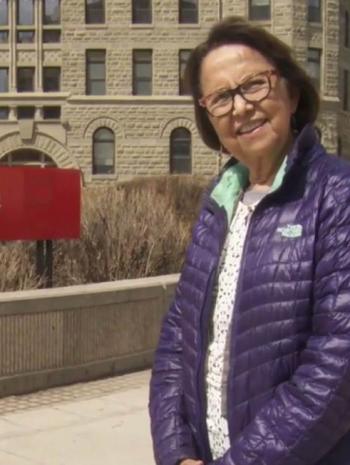Image Caption
By Windspeaker.com Staff
With files from Jeremy Harpe of CFWE-FM
Prior to her heart transplant in 2004, Esther Sanderson paid very little attention to heart health. “I was busy living my life,” she told Jeremy Harpe of CFWE-FM. She ate well, she thought, though that was difficult with all the travel she was doing in the north. She exercised and she was never a smoker or a drinker, not even occasionally.
And, as an Aboriginal woman, she took care of her spiritual needs by attending ceremonies whenever possible.
Still, one day while she was traveling by car from Prince Albert to Regina, she began to feel an intense pain in her abdomen.
As the pain increased, she phoned a friend who is the nursing director of the First Nations University of Canada, who convinced Sanderson something was seriously wrong.
Her friend drove out to the highway and took Sanderson to the hospital in Prince Albert where she took an ECG. It came back normal.
Knowing that heart attack symptoms can be more subtle in women than in men, the friend insisted that the test be repeated, and then a third ECG finally confirmed that Sanderson was in crisis.
She was taken by ambulance to Saskatoon and then evacuated by air to Edmonton’s University Hospital. There Sanderson learned her heart was badly damaged and a transplant was her only hope of survival. A heart machine pumped blood through her body until a healthy heart could be found.
Sanderson, currently the director of Aboriginal languages and culture at University College of the North in The Pas, Man., spent three months in hospital after the transplant and another two months as an out-patient. And during this time she received quite an education.
“What I learned about the hospital was that there was a lot of protocol, and it’s not always easy to navigate. If I was there by myself, I don’t think I could have managed. ”She met other women who had experienced heart disease, and Indigenous women who didn’t have success with their treatments.
“Too often people give up and die in despair or are sent home with Aspirins, where they sometimes die,” Esther says in an article at http://www.heartandstroke.ca/articles/esthers-story-a-healing-combination
“The care and treatment they receive at the very beginning is crucial. If that doesn’t work well, they are reluctant to return, reluctant to question or challenge.”
Sanderson said her family, and mainly her daughter, helped her to navigate the system. Family provided advocacy when she needed it. Looking back at her own health crisis, she sees a connection to the decline in the practices of Indigenous traditional ways of keeping healthy.
Many of those practices were banned by government, and many today are dismissed by western medicine. Even Indigenous foods are being replaced by less healthy foods.
She recalled a time when she wanted to buy a piece of watermelon on a northern reserve, only to learn that it cost $13. A bag of chips and pop cost only a dollar.
After her heart surgery, Sanderson was very, very sick. Because of the shock to her body, she ended up with diabetes and was also put on dialysis for months. Family brought her traditional medicines, but it wasn’t easy to convince the western doctors to allow it.
“Nevertheless, I did take the medicine.”
“Taking me to the ceremonial room every day, when I was strong enough to be able to go, was important for my health and recovery,” she said. An Elder there said prayers for her and there was a singer who used the drum.
“I found that tremendously uplifting to hear these songs and these prayers.”
Sanderson said women must take the time to take care of themselves, and to look at health in a holistic manner—emotionally, mentally, spiritually and physically healthy.
Most of the battle of being healthy is up to the individual, she said.
“We all know intuitively what will make us better.”
Drugs and surgery are not always the answer, she said.
“We have traditional medicines in our community that we can use. And, when we’re not feeling well, we should proactively try and take care of it
.“I can’t stress it enough. We can’t give all the responsibility to doctors to take care of our health. That’s what I would tell women about heart health.”

